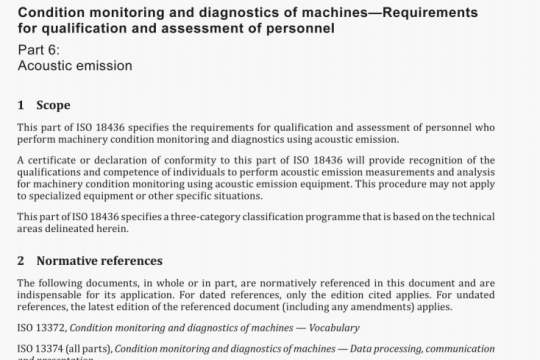ISO 17161:2014 pdf free
ISO 17161:2014 pdf free.Fine ceramics (advanced ceramics, advanced technical ceramics)一Ceramic composites
A rectangular cross section of a reference test specimen (Clause 7) equipped with 10 strain gauges is loaded in tension or in compression, up to a load corresponding to 10 % of the nominal load capacity of the load cell used for the tests of CMCs. The stress corresponding to this value shall not exceed 50 % of the elasticity limit of the material used for the reference test specimen. The readings obtained from the strain gauges bonded on the calibrated length of the reference test specimen allow the determination
of the degree of misalignment.
The positioning of strain gauges is such that it indicates the magnitude of defects. These magnitudes allow the correction, in a practical manner, of the different types of defects:
一bending defects, either C (Figure 1) or S (Figure 2);
一torsion (Figure 3).
The indications for correction are obtained by comparing the experimental readings of the strain gauges to values from charts established from numerical simulations.
It is essential to protect strain gauges and adhesives from effects due to moisture and other degrading contaminants. Therefore, it is recommended that after installation of the strain gauges, a layer of protective coating material such as strain-gauge -grade silicone rubber is applied.
Periodically check the response of the strain gauges by comparing Young’s modulus of the steel, the reference test specimen is made from, determined for each location of the strain gauges, to the value of Young’s modulus determined during the first utilization of the reference test specimen by the same method.
The difference between these two values shall not exceed 5 %. This value shall be indicated more accurately when more experimental results are made available.
It is recommended to do this verification once a year.
The test report shall be in accordance with the reporting provisions of ISO/IEC 17025 and shall contain at least the following information:
a) the name and address of the testing establishment;
b) date of test;
c) on each page, a unique report identification and page number;
d) customer name and address;
e) a reference to this International Standard, i.e. determined in accordance with ISO 17161;
f) an authorizing signature;
g) any deviation from the method described, with appropriate validation, i.e. demonstrated to be acceptable to the parties involved;
h) a description of the equipment used;
i) reference test specimen used, if different from the recommended one;
j) test specimen drawing;
k) the dimensions of all strain gauges used, expressed in millimetres;ISO 17161 pdf download.




